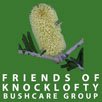|
Gahnia radula
Gastrodium sesamoides
Goodenia lanata
Goodenia ovata
Juncus pallidus
Juncus sarophorus
ViewFlora Descriptions and images
A|B|C|D|E|G-J|L|M-O|P|S-Z
|
Knocklofty Reserve Flora - G-J
Gahnia radula, common name "Thatch saw-edge", is wide spread on Knocklofty Reserve especially in the sandstone area south east of the Forest Road carpark and along the upper side of the Main Trail near the Glover Track junction. This species is the only food and habitat species for the rare and endangered butterfly species, Chaostola skipper. The Chaostola skipper caterpillar binds 2 or 3 of the Gahnia radula's strappy leaves together about half way up their length and forms a round cocoon in which the caterpillar spends the day upside down for about two years. At night the caterpillar climbs down out of the cocoon and feeds on the edges of the Gahnia radula leaves near their top. Gahnia radula grows 0.3 to 2m high by 0.3 to 2m wide as a clumping perennial herb, spreading by underground rhizomes (roots that have nodules from which new surface stems can grow). It has deep green, rough, sharp edged leaves up to 2m long by 6mm wide and dark brown, sometimes pendulous flower stems off the leaf stems up to 60cm long by 7cm wide. It prefers damp soil but can tolerate extended dry periods and frosts. This species is also known to be used as nesting sites for Blue wrens and the seeds provide food for Rosella parrots. The foliage has been used for roof thatching, hence the common name.
View Images
Gastrodium sesamoides, common name "Potato Orchid", has been found amid a collection of rocks near the Knocklofty Reserve summit and may also be found in other locations. The 5 to 25 well-spaced, brown, downward facing flowers on a stout brown leafless stem appear in late spring to midsummer. This is an interestingly different orchid that is very easily recognized and found in a moderately large community.
View Image
Goodenia lanata, common name "Trailing native-primrose", is found wide spread in the Knocklofty Reserve, notably in the wayleave north of Trig Hill and the grassy areas near the Bandicoot Corridor. It is a spreading, ground covering herb with hairy new, dark green leaves and solitary, yellow, five petalled flowers in spring through to summer. It prefers well drained moist soils in partial sun and can make a good small rockery plant in home gardens.
View Images
Goodenia ovata, common name "Hop native-primrose", is a small shrub, growing 1 to 2m high by 0.5 to 1.5m wide with yellow, five petalled, long stemmed flowers that appear all the year round, especially in spring. This lovely species is found growing in dryer areas throughout the Knocklofty Reserve in most soils and part to full sun. In home gardens it should be regularly pruned to retain shape and encourage a bushy habit. It is an excellent species for revegetation and is a roadside coloniser. It is one of the first species to revegetate bush fire ravaged areas.
View Images
Juncus pallidus, common name "Pale rush", grows widely in Knocklofty Reserve and a good example may be found in the grassy area south east of the Bandicoot Corridor. It grows 0.5 to 2.3m high by 0.3 to 1m wide with pale green stems 3 to 8mm in diameter and a single cluster of straw coloured flowers almost at the top of the stems in summer through to early autumn. It is frost hardy in most soils and withstands periods of dryness.
View Images
Juncus sarophorus, common name "Broom rush", grows in most of the ponds in Knocklofty Reserve, especially Janets Pond (syn. Frog Dam), the Frog Bog and the Aussat Pond. It is a perennial herb growing in tussocks, 0.6 to 2m high by 0.5m to 1m wide with pointed bluish green stems to 4mm diameter and a single cluster of pale brown to whitish flowers in late spring to early autumn. It makes an excellent refuge for birds when mass planted, is frost hardy and withstands short periods of dryness.
View Images
|



